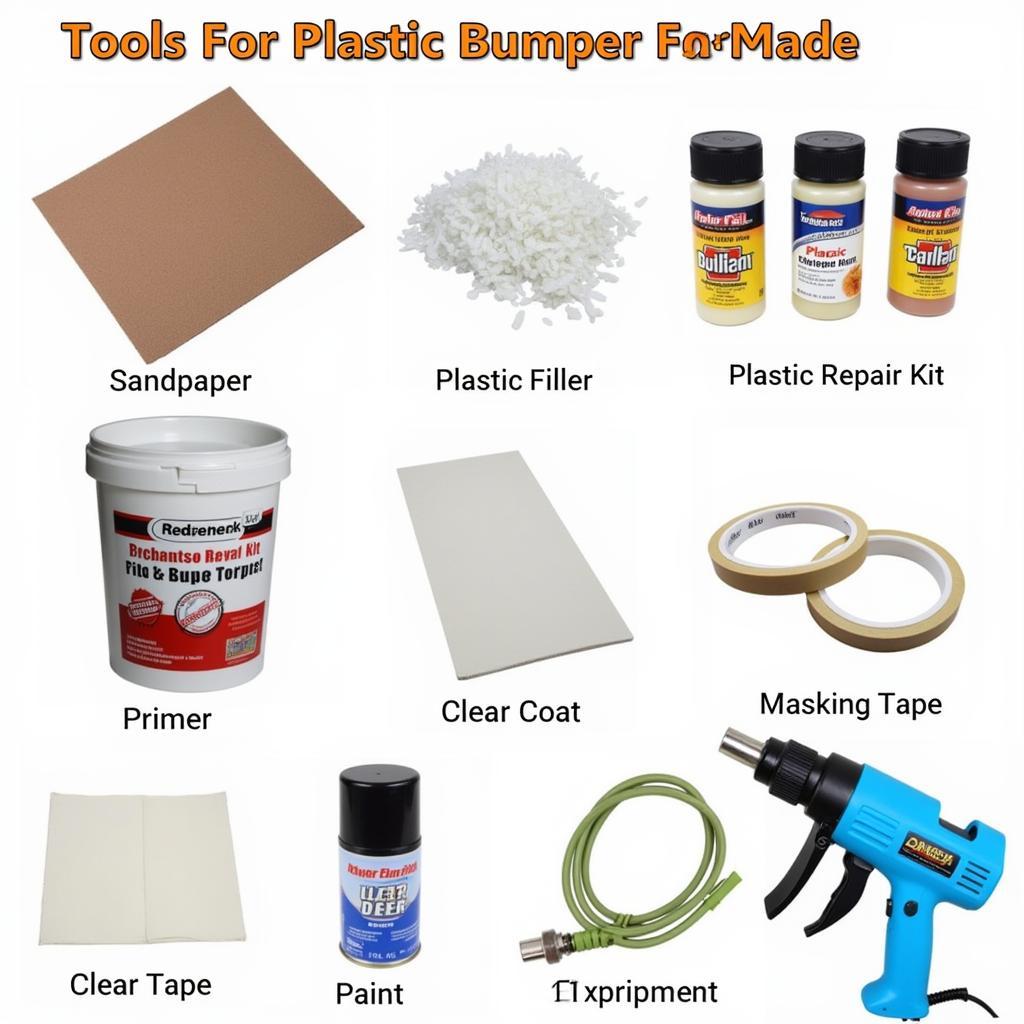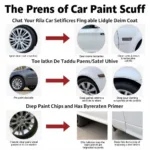A damaged bumper detracts from your car’s appearance and can be costly to replace. Learning how to repair a broken car bumper yourself can save you significant money and is often a surprisingly manageable DIY project. This guide will cover the most common types of bumper damage and provide step-by-step instructions for effective repair.
Assessing the Damage: Know Your Bumper
Before starting any repairs, it’s crucial to assess the extent of the damage. Is it a minor scratch, a deep crack, or a complete break? The material of your bumper also plays a significant role. Most modern bumpers are made of plastic, specifically thermoplastic olefin (TPO) or polypropylene (PP), which are repairable with specific techniques. Older cars may have bumpers made of fiberglass or metal, which require different approaches. Identifying the material is the first step towards a successful repair.
how do you repair a broken plastic car bumper provides further insight into the nuances of plastic bumper repair.
What are the common signs of bumper damage?
- Cracks or splits in the bumper cover.
- Dents or depressions in the bumper.
- Paint scratches or chips.
- Detached or broken bumper clips.
- Misaligned bumper.
Knowing the severity and type of damage will determine the necessary tools and materials.
Gathering Your Tools and Materials for Bumper Repair
Once you’ve assessed the damage, gather the necessary tools and materials. For plastic bumper repair, you’ll likely need:
- Cleaning supplies (soap, water, degreaser)
- Sandpaper (various grits)
- Plastic filler/body filler
- Plastic repair kit (for cracks and holes)
- Primer
- Paint (matched to your car’s color)
- Clear coat
- Masking tape and paper
- Heat gun or hair dryer (for plastic welding)
- Safety glasses and gloves
Step-by-Step Guide to Repairing a Broken Car Bumper
Repairing a broken plastic car bumper involves several key steps:
- Clean the Area: Thoroughly clean the damaged area with soap and water, then degrease it. This ensures proper adhesion of the repair materials.
- Sand the Damaged Area: Sand the damaged area with progressively finer grits of sandpaper to smooth the surface and remove any loose paint or plastic.
- Apply Plastic Filler: If there are dents or deep scratches, apply plastic filler according to the manufacturer’s instructions. Allow it to dry and cure completely.
- Repair Cracks and Holes: Use a plastic repair kit to mend cracks and holes. This usually involves applying a reinforcing mesh and then filling the area with plastic repair adhesive. A heat gun or hair dryer can help meld the plastic together. You might find how to repair broken plastic car bumper helpful in this stage.
- Sand and Smooth: Once the filler and adhesive have dried, sand the repaired area smooth, blending it with the surrounding bumper.
- Prime and Paint: Apply primer to the repaired area. Once dry, apply several thin coats of paint that matches your car’s color, allowing each coat to dry before applying the next.
- Apply Clear Coat: Finish with a few coats of clear coat to protect the paint and give it a glossy finish.
For issues with bumper clips or locks, car bumper clips repair and car bumper lock repair provide specialized guidance.
John Smith, a veteran auto body technician, advises, “Patience is key when repairing a bumper. Take your time with each step, and don’t rush the drying and curing process.”
Minor Bumper Repair: Scratches and Scuffs
For minor scratches and scuffs, you may not need filler. Cleaning, sanding, and touch-up paint can often suffice. car bumper smart repair offers more details on these techniques.
Jane Doe, an automotive paint specialist, emphasizes, “Matching the paint color precisely is crucial for a seamless repair. Use a paint code finder or consult with a paint specialist to get the right match.”
Conclusion: Restoring Your Bumper’s Integrity
Repairing a broken car bumper can be a rewarding DIY project. By following these steps and utilizing the resources provided, you can restore your bumper’s appearance and save money. Remember to prioritize safety and take your time with each step to achieve the best results. Now you know how to repair a broken car bumper!
FAQ
- Can I repair a cracked bumper myself? Yes, in many cases you can repair a cracked bumper yourself with the right tools and materials.
- What type of plastic are most car bumpers made of? Most modern bumpers are made of thermoplastic olefin (TPO) or polypropylene (PP).
- Do I need a heat gun to repair a plastic bumper? A heat gun or hair dryer can be helpful for welding plastic and ensuring a strong bond.
- How long does it take to repair a bumper? The repair time depends on the extent of the damage, but it can range from a few hours to a couple of days, including drying time.
- Where can I find the paint code for my car? The paint code is usually located on a sticker inside the driver’s side doorjamb, the glove compartment, or the owner’s manual.
- Can I repair a metal bumper? Yes, metal bumpers can be repaired, but they require different techniques than plastic bumpers, often involving welding and bodywork.
- How much does it cost to repair a bumper professionally? Professional bumper repair costs can vary significantly depending on the extent of the damage and the shop’s rates.
Need help?
Contact us via WhatsApp: +1(641)206-8880 or Email: [email protected]. Our customer support team is available 24/7.


